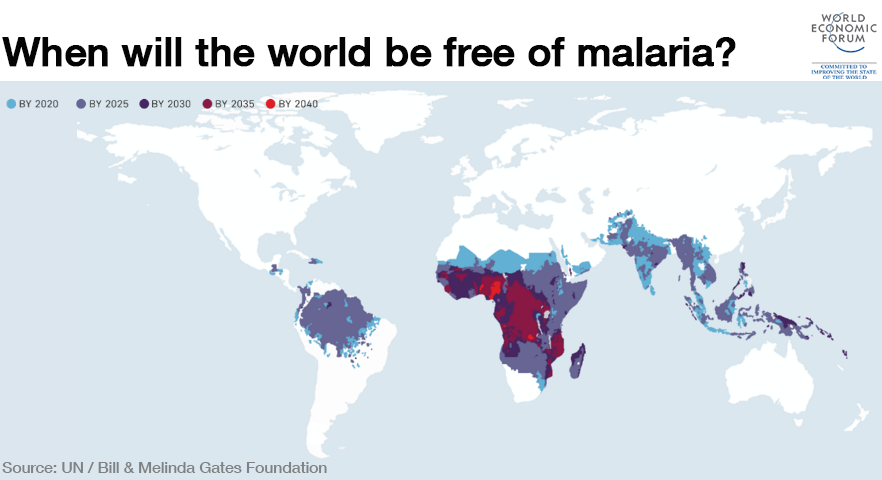A timeline of our efforts to eradicate malaria - how close are we?

To outpace rising resistance, Seattle's malaria-fighting community is developing innovations. Image: REUTERS/Damir Sagolj
In Seattle, which has been dubbed the "Silicon Valley of saving lives", thousands of scientists, engineers and entrepreneurs are working on innovations to end malaria.
The city boasts at least 160 organisations working on global health and is home to the world's richest couple, Bill and Melinda Gates, whose global health and education foundation has set a target to eradicate the deadly disease by 2040.
Yet efforts to end malaria, which killed an estimated 438,000 people in 2015, are under threat as mosquitoes become increasingly resistant to drugs and insecticides.
To outpace rising resistance, Seattle's malaria-fighting community is developing innovations ranging from data modelling and genetic modification to single-dose drugs and sugar traps.

Here are key dates in the drive to end malaria:
1947 - The United States launches the National Malaria Eradication Program. The disease had caused widespread illness among soldiers training in the southern U.S. during World War Two. Almost 5 million homes are sprayed with DDT insecticide and mosquito breeding sites are drained.
1951 - Malaria is eliminated in the United States.
1955 - The World Health Organization (WHO) launches the Global Malaria Eradication Program (GMEP). Malaria is eliminated in more than two dozen countries in Europe, the Americas and Asia, mainly by spraying with DDT and using the cheap and effective drug chloroquine. Most of Africa is excluded due to logistical difficulties.
1969 - The WHO suspends GMEP due to drug and insecticide resistance and funding shortages.
1975 - Europe is declared malaria free. The disease had been endemic in southern countries like Italy, Greece and Portugal.
1979 - Tunisia eliminates malaria.
1987 - Scientists working in GlaxoSmithKline laboratories create the Mosquirix malaria vaccine candidate.
1990s - Malaria re-emerges in Europe's Caucasus region, Central Asia, the Russian Federation and Turkey due to population movements and reduced prevention measures.
1998 - WHO launches the Roll Back Malaria initiative, leading to increased investment in cheap new drugs, tests and insecticide-treated bed nets.
2005 - President George W. Bush sets up the U.S. President's Malaria Initiative with the aim of halving malaria-related deaths in 15 high-burden African countries.
2007 - Results of phase II clinical trials of Mosquirix in Mozambique show it provides partial protection against malaria.
2009 - Mosquirix phase III field trials begin. It is Africa's largest malaria vaccine trial to date, involving 15,000 infants and children in seven countries.
2010 - Morocco eliminates malaria.
2011 - Trial data from Africa shows Mosquirix halves the number of malaria episodes in children aged five to 17 months.
2014 - A study in the New England Journal of Medicine finds widespread resistance to the world's most effective antimalarial drug, artemisinin, across Southeast Asia, threatening global control efforts.
2015 - Mosquirix receives a green light from European Union drug regulators who recommend it to be licensed for use.
2015 - The world meets the Millennium Development Goal to halt and reverse the incidence of malaria. Global leaders set a Sustainable Development Goal to end epidemic levels of malaria by 2030.
2016 - The WHO invites African countries to take part in a Mosquirix vaccine pilot involving up to 800,000 children aged five to nine months.
Sources: U.S. Centers for Disease Control and Prevention, World Health Organization, PATH Malaria Vaccine Initiative, U.S. President's Malaria Initiative.
This article is published in collaboration with The Thomson Reuters Foundation trust.org. Publication does not imply endorsement of views by the World Economic Forum.
To keep up with the Agenda subscribe to our weekly newsletter.
Don't miss any update on this topic
Create a free account and access your personalized content collection with our latest publications and analyses.
License and Republishing
World Economic Forum articles may be republished in accordance with the Creative Commons Attribution-NonCommercial-NoDerivatives 4.0 International Public License, and in accordance with our Terms of Use.
The views expressed in this article are those of the author alone and not the World Economic Forum.
Stay up to date:
Future of Global Health and Healthcare
Forum Stories newsletter
Bringing you weekly curated insights and analysis on the global issues that matter.
More on Health and Healthcare SystemsSee all
Mansoor Al Mansoori and Noura Al Ghaithi
November 14, 2025







